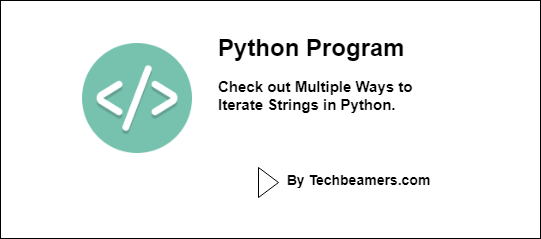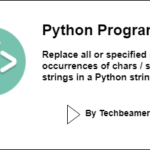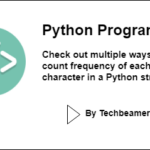In this tutorial, you will find out different ways to iterate strings in Python. You could use a for loop, range in Python, a slicing operator, and a few more methods to traverse the characters in a string.
Multiple Ways to Iterate over Strings in Python
The following are various ways to iterate the chars in a Python string.
1. Using for loop
2. Python range function
3. Using the slice operator partially
4. Traverse the string backward using the slice operator
5. By using the indexing method
Let’s first begin with the “for loop” method.
1. Using for loop to traverse a string
It is the most prominent and straightforward technique to iterate strings. Follow the below sample code:
""" Python Program: Using for loop to iterate over a string in Python """ string_to_iterate = "Data Science" for char in string_to_iterate: print(char)
The result of the above coding snippet is as follows:
D a t a S c i e n c e
2. Python range to iterate over a string
Another quite simple way to traverse the string is by using the Python range function. This method lets us access string elements using the index.
Go through the sample code given below:
""" Python Program: Using range() to iterate over a string in Python """ string_to_iterate = "Data Science" for char_index in range(len(string_to_iterate)): print(string_to_iterate[char_index])
The result of the above coding snippet is as follows:
D a t a S c i e n c e
3. Slice operator to iterate strings partially
You can traverse a string as a substring by using the Python slice operator ([]). It cuts off a substring from the original string and we can iterate over it partially.
The [] operator has the following syntax:
# Slicing Operator string [starting index : ending index : step value]
To use this method, provide the starting and ending indices along with a step value and then traverse the string. Below is the example code that iterates over the first six letters of a string.
""" Python Program: Using slice [] operator to iterate over a string partially """ string_to_iterate = "Python Data Science" for char in string_to_iterate[0 : 6 : 1]: print(char)
The result of the above coding snippet is as follows:
P y t h o n
You can take the slice operator usage further by using it to iterate over a string but leaving every alternate character. Check out the below example:
""" Python Program: Using slice [] operator to iterate over a specific parts of a string """ string_to_iterate = "Python_Data_Science" for char in string_to_iterate[ : : 2]: print(char)
The result of the above coding snippet is as follows:
P t o _ a a S i n e
4. Traverse the string backward using the slice operator
If you pass a -ve step value and skip the starting as well as ending indices, then you can iterate in the backward direction. Go through the given code sample.
""" Python Program: Using slice [] operator to iterate string backward """ string_to_iterate = "Machine Learning" for char in string_to_iterate[ : : -1]: print(char)
The result of the above coding snippet is as follows:
g n i n r a e L e n i h c a M
5. Use indexing to iterate strings backward
The slice operator first generates a reversed string, and then we use the for loop to traverse it. Instead of doing it, we can directly use the indexing method to traverse the string backward.
""" Python Program: Using indexing to iterate string backward """ string_to_iterate = "Machine Learning" char_index = len(string_to_iterate) - 1 while char_index >= 0: print(string_to_iterate[char_index]) char_index -= 1
The result of the above coding snippet is as follows:
g n i n r a e L e n i h c a M
Alternatively, we can pass the -ve index value and traverse the string backward. See the below example.
""" Python Program: Using -ve index to iterate string backward """ string_to_iterate = "Learn Python" char_index = 1 while char_index <= len(string_to_iterate): print(string_to_iterate[-char_index]) char_index += 1
The result of the above coding snippet is as follows:
n o h t y P n r a e L
Summary – Program to iterate over strings char by char
Let’s now consolidate all examples inside the Main() function and execute from there.
"""
Program:
Python Program to iterate strings char by char
"""
def Main():
string_to_iterate = "Data Science"
for char in string_to_iterate:
print(char)
string_to_iterate = "Data Science"
for char_index in range(len(string_to_iterate)):
print(string_to_iterate[char_index])
string_to_iterate = "Python Data Science"
for char in string_to_iterate[0 : 6 : 1]:
print(char)
string_to_iterate = "Python_Data_Science"
for char in string_to_iterate[ : : 2]:
print(char)
string_to_iterate = "Machine Learning"
for char in string_to_iterate[ : : -1]:
print(char)
string_to_iterate = "Machine Learning"
char_index = len(string_to_iterate) - 1
while char_index >= 0:
print(string_to_iterate[char_index])
char_index -= 1
string_to_iterate = "Learn Python"
char_index = 1
while char_index <= len(string_to_iterate):
print(string_to_iterate[-char_index])
char_index += 1
if __name__ == "__main__":
Main()The result of the above coding snippet is as follows:
D a t a S c i e n c e D a t a S c i e n c e P y t h o n P t o _ a a S i n e g n i n r a e L e n i h c a M g n i n r a e L e n i h c a M n o h t y P n r a e L









